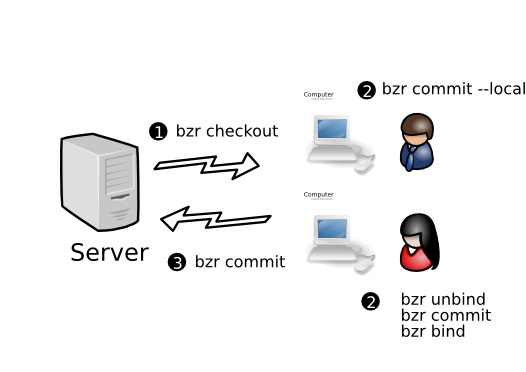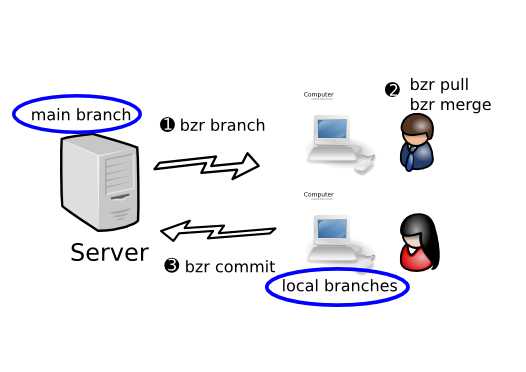Workflows¶
Breezy is just a tool¶
Breezy supports many different ways of working together. This means that you can start with one workflow and adapt it over time as circumstances change. There is no “one true way” that always makes sense and there never will be. This section provides a brief overview of some popular workflows supported by Breezy.
Keep in mind that these workflow are just some examples of how Breezy can be used. You may want to use a workflow not listed here, perhaps building on the ideas below.
Solo¶
Whether developing software, editing documents or changing configuration files, having an easy-to-use VCS tool can help. A single user can use this workflow effectively for managing projects where they are the only contributor.

Advantages of this workflow over not using version control at all include:
backup of old versions
rollback to an earlier state
tracking of history.
The key features of Breezy appropriate for this workflow are low administration (no server setup) and ease of use.
Partner¶
Sometimes two people need to work together sharing changes as they go. This commonly starts off as a Solo workflow (see above) or a team-oriented workflow (see below). At some point, the second person takes a branch (copy including history) of what the first person has done. They can then work in parallel exchanging changes by merging when appropriate.

Advantages over Solo are:
easier sharing of changes
each line of each text file can be attributed to a particular change including who changed it, when and why.
When implementing this workflow, Breezy’s advantages over CVS and Subversion include:
no server to setup
intelligent merging means merging multiple times isn’t painful.
Centralized¶
Also known as lock-step, this is essentially the same as the workflow
encouraged/enforced by CVS and Subversion. All developers work on the same
branch (or branches). They run brz update to get their checkout up-to-date,
then brz commit to publish their changes to the central location.

Subversion and CVS are good choices for implementing this workflow because they make it easy. Breezy directly supports it as well while providing some important advantages over CVS and Subversion:
better branching and merging
better renaming support.
Centralized with local commits¶
This is essentially the same as the Centralized model, except that when
developers are making a series of changes, they do commit --local or unbind
their checkout. When it is complete, they commit their work to the shared
mainline.

Advantages over Centralized:
Can work offline, e.g. when disconnected during travel
Less chance for a bad commit to interfere with everyone else’s work
Subversion and CVS do not support this model. Other distributed VCS tools can support it but do so less directly than Breezy does.
Decentralized with human gatekeeper¶
In this workflow, each developer has their own branch or branches, plus read-only access to the main branch. One developer (the gatekeeper) has commit rights to the main branch. When a developer wants their work merged, they ask the gatekeeper to merge it. The gatekeeper does code review, and merges the work into the main branch if it meets the necessary standards.

Advantage over Decentralized with shared mainline:
Code is always reviewed before it enters the mainline
Tighter control over when changes get incorporated into the mainline.
A companion tool of Breezy’s called Bundle Buggy can be very useful for tracking what changes are up for review, their status and reviewer comments.
Decentralized with automatic gatekeeper¶
In this workflow, each developer has their own branch or branches, plus read-only access to the mainline. A software gatekeeper has commit rights to the main branch. When a developer wants their work merged, they request another person to review it. Once it has passed review, either the original author or the reviewer asks the gatekeeper software to merge it, depending on team policies. The gatekeeper software does a merge, a compile, and runs the test suite. If and only if the code passes, it is merged into the mainline.
Note: As an alternative, the review step can be skipped and the author can submit the change to the automatic gatekeeper without it. (This is particularly appropriate when using practices such as Pair Programming that effectively promote just-in-time reviews instead of reviewing code as a separate step.)

Advantages over Decentralized with human gatekeeper:
Code is always tested before it enters the mainline (so the integrity of the mainline is higher)
Scales better as teams grow.
A companion tool of Breezy’s called Patch Queue Manager (PQM) can provide the automated gatekeeper capability.
Implementing a workflow¶
For an in-depth look at how to implement each of the workflows above, see chapters 3 to 6 in this manual. First though, chapter 2 explains some important pre-requisites including installation, general usage instructions and configuration tips.
